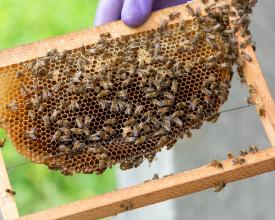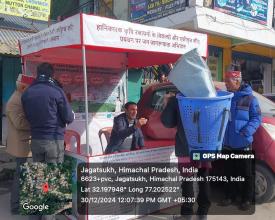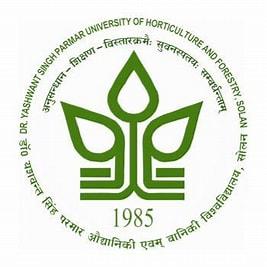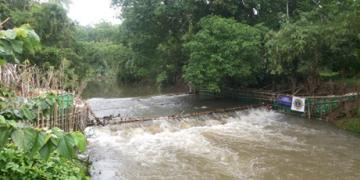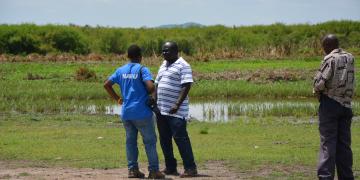
Promoting pollination as an ecosystem service for climate resilience and agroecology
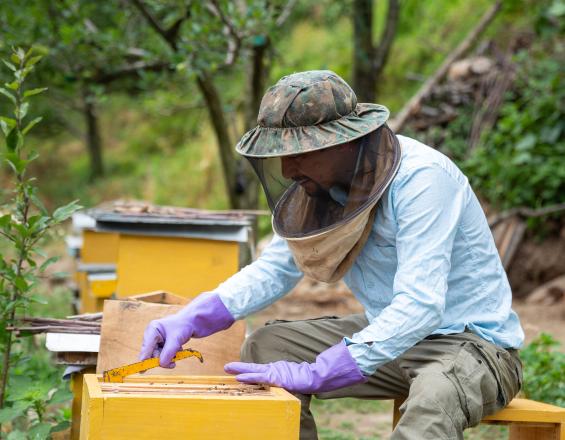
Declining pollinator populations are threatening fruit quality, yields and farmer incomes in Himachal Pradesh’s apple orchards. To improve production and climate resilience, the Green Innovation Centres for the Agriculture and Food Sector - India promoted pollination as an ecosystem service in cooperation with its partners Dr Y S Parmar University for Horticulture & Forestry (UHF) and the Keystone Foundation. Implemented in Shimla and Kullu, the project focused on the conservation of native pollinators like Apis cerana bees and scientific pollination management. Activities included training farmers and micro-entrepreneurs in beekeeping and honey processing, fostering the establishment of mud hives and bee hotels, enhancing seasonal bee flora, and reducing pesticide use among others through a large-scale awareness campaign. Improved pollination boosts fruit size and quality, reduces June drop and supports resilience to climate and weather-related risks, while beekeeping offers farmers diversified income opportunities.
Contexte
Challenges addressed
Environmental challenges:
Insect pollinator populations - including wild bees, butterflies, moths, and honeybees - are in decline due to monoculture farming, excessive pesticide use, loss of natural habitats, and climate change hazards like increasing temperatures. This threatens biodiversity and reduces the availability of pollination services critical for fruit set and sustainable agriculture.
Social challenges:
There is limited knowledge about pollination methods, the ecological role of pollinators, and risks posed by harmful pesticide practices. Without this understanding, pollination-supportive measures are not widely adopted and often undermined.
Economic challenges:
Poor pollination reduces apple yields and fruit quality, directly affecting farmer incomes. Smaller and irregular fruits fetch lower prices, and premature fruit drop further reduces marketable produce.
Emplacement
Traiter
Summary of the process
The building blocks complement each other by addressing pollinator protection from multiple angles. Broad-based awareness raising created the foundation for change across farming communities and involved other relevant parts of the community such as local decision makers and students, who will significantly influence future farming practices. Practical measures like promoting bee-friendly practices and establishing on-farm nesting sites enabled farmers to actively protect and support pollinator populations. Introducing beekeeping and honey processing further created direct livelihood benefits, strengthening the economic incentives for sustainable, pollinator-friendly orchard management. Together, the building blocks address the different changes needed at farmer, community, and system level to enable a shift towards more sustainable and pollinator-friendly farming practices in apple cultivation.
Building Blocks
Awareness Raising on the Importance of Native Insect Pollinators for Apple Cultivation
Regional biodiversity and pollination services are influenced by the collective choices made by all farmers, local institutions, and other stakeholders in a community, especially regarding the use of chemical inputs. To foster broader awareness and behavioural change, the project rolled out an awareness campaign that extended beyond the project’s direct beneficiaries. It reached over 2,000 people across Shimla and Kullu, including the wider farming community, students and local decision-makers. The awareness workshops were conducted in 15 village-level meetings in the local Gram Panchayats (local governance bodies), sessions in 20 schools, colleges, and industrial training centres, and workshops with 49 local Self-Help Groups.
In a more targeted component, the project conducted in-depth workshops with six collaborating Farmer Producer Companies (FPCs) directly aimed at changing on farm practices. At these and other campaign events, participants shared specific problems, discussed challenges, and proposed alternatives to harmful pesticides and chemical fertilizers, drawing on their own experiences and local practices.
Modules on pollinator management and conservation were integrated into pollination management trainings of the project, which were anchored with UHF and the Department of Horticulture (DoH).
Enabling factors
The project conducted a joint workshop with the UHF and the DoH, for enabling feedback from policy and research institutions. Engaging awareness materials in local language were created along with succinct slogans and a narrative that farmers can easily grasp. A targeted outreach campaign covering village gatherings, educational institutes, and local fairs ensured maximum outreach.
Lesson learned
An important lesson was that behaviour change communication must account for cultural contexts. Additionally, narratives for awareness on harmful chemicals used must not target private business enterprises making them or even the farmers using them, but keep their focus on the negative impacts on human and environmental health.
Protecting Wild Pollinators
The simplest and cheapest pollination measure is the protection of bees and other pollinators in orchards, as these insects play an essential role in pollinating fruit trees. To this end, the project promoted a dual approach which combines protective farming practices with the creation of on-farm habitats for pollinators.
Farmers were introduced to integrated pest management (IPM), which emphasizes alternatives to chemical pesticides as well as techniques such as scouting and pruning to reduce pest incidence. They were also encouraged to adopt bee-friendly practices such as avoiding pesticide use during flowering, applying only when necessary, with the right techniques and appropriate dosages, maintaining floral diversity throughout the year, and to closely coordinate with beekeepers. These measures help reduce harm to pollinators, cut input costs, and minimize chemical residues.
Complementing these practices, farmers installed simple, locally made nesting structures such as mud hives and bee hotels to support indigenous honeybees and wild pollinators. These native species are well adapted to local conditions and often remain active under cooler temperatures, making them especially valuable during critical flowering periods.
Enabling factors
- Promotion of low-cost, easy-to-adopt practices aligned with farmers' existing knowledge and resource availability.
- Use of locally available materials for constructing simple nesting structures like mud hives and bee hotels.
Lesson learned
- Close involvement of farmers from the beginning in piloting new techniques ensured their wider adoption
- Dissemination of best practices by UHF and their scientific backstopping ensured institutional anchoring
Diversification of Farmer Livelihoods through Beekeeping and Honey Processing
To complement pollination-related benefits and promote income diversification, the project introduced beekeeping and honey processing as an additional livelihood activity for apple-growing households. Farmers and micro-entrepreneurs were supported to integrate beekeeping into their existing farming systems, with a focus on the use of the native honeybee species Apis cerana. Participants received training on beekeeping practices, hive management, and the value-added processing of honey and related products. These activities contribute to increased resilience through alternative income sources and create economic incentives to conserve pollinator populations.
Enabling factors
- Availability of native honey bee species well adapted to the local climate and landscape
- Training and technical guidance provided as part of project activities
- Value-addition potential through honey processing and marketing
Lesson learned
- Beekeeping offers a viable livelihood addition for apple farmers
Economic incentives such as honey sales can reinforce pollinator-friendly farming practices
Impacts
Environmental impacts
The project contributed to the conservation of wild pollinators and the promotion of indigenous species like Apis cerana, improving biodiversity and ecological balance in apple orchards. Reduced pesticide use, greater floral diversity, and creation of on-farm habitats enhanced pollination services. Habitat conservation also helps the pollinators adapt to climatic changes, and increased pollination services make apple yields and quality resilient.
Social impacts
Beyond technical training, the project mobilized farmers, Self-Help Groups, and local institutions to integrate pollinator protection into daily agricultural practices. Village meetings, school sessions, and engagement with local governance bodies created lasting awareness and helped embed biodiversity-friendly approaches within farming communities in Himachal Pradesh.
Economic impacts
Improved pollination enhances fruit set, increases the proportion of well-developed apples, and reduces early fruit drop by supporting stronger seed and fruit development. As a result, farmers can achieve higher marketable yields, better fruit quality, and higher prices. Diversification into beekeeping and honey processing strengthened the incomes of engaged farmers and created economic incentives for conserving pollinator, as well as make farmer livelihoods resilient to climate change.
Beneficiaries
80 farmers and micro-entrepreneurs in Shimla and Kullu were trained in beekeeping and pollination practices. Apple growers benefited from improved yield and income. Native bees and wild pollinators benefited from restored habitat and reduced pesticide use.
Global Biodiversity Framework (GBF)
Sustainable Development Goals
Story
Together with his family of four, the 37-year-old farmer Kishan Chand tends to their small apple orchard in a picturesque mountain village close to Manali, nestled in the foothills of the Indian Himalayas. Apart from tourism, apple cultivation, which alone contributes 5% to the economy of Himachal Pradesh, is the main sector the village economy depends on. The challenge of declining pollinator populations and decreasing farm productivity has, however, not spared their farm, requiring a rethinking of how to sustain their livelihood.
Always eager to start his own business and in search of solutions for their challenges, Mr. Kishan used the opportunity provided through his membership in the Farmer Producer Organisation KPM to attend multiple trainings by GIC. He participated in courses on Nutrition Management, Pollination Management, Integrated Pest Management, and Canopy Management.
By 2021, the knowledge and skills on bee behaviour, hive management, honey extraction techniques, and disease control measures, which he developed during the trainings, allowed him to become a beekeeper himself and to add an additional source of livelihood for his family. As a jumpstart, he was also provided with one box hive and a colony of Apis cerana bees and has now started renting the box hives to other farmers for pollination on their respective orchards, while also expanding the number of bee boxes on his own farm.
Mr. Kishan has multiplied the bee colonies gradually over time, expanding to 25 boxes of Apis cerana indica. He recently bought 45 ISI 10- to 11-frame bee boxes, comprising 10 super hives priced at 18 Euro per box and 35 normal hives priced at 15.5 Euro per box.
He produced 50 kg of honey from 2021 to 2024 and sold 40 kg of honey priced between 12–14.5 Euro per kg. Additionally, for renting out bee boxes to other farmers, he charges between 9–12 Euro per box per month. Kishan is now taking steps towards pursuing other income-generating activities and products from beekeeping, such as beeswax and queen rearing. He has successfully produced half a kilogram of beeswax already.
To take his beekeeping practices forward, Mr. Kishan aims to leverage his skills to transition into a commercial beekeeping business. His focus will be on increasing bee hives and honeybees, as well as the production of honey and other bee products. Value-addition of these products is a long-term strategy, while ensuring the well-being of the bees and the quality of their products.

